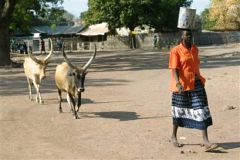Violence in Sudan’s Darfur threatens South
By RODRIQUE NGOWI, Associated Press Writer
RUMBEK, Sudan, Jan 21, 2005 (AP) — A tenuous agreement to end Africa’s longest-running civil war has brought joy and hope to southern Sudan, along with international pledges to help develop the devastated region. But U.N. officials warn all that could be derailed if the conflict in the country’s western Darfur region persists.

|
|
Cattle follow a woman through central Rumbek, Thursday, Jan. 20, 2005 in southern Sudan. (AP). |
“Peace is indivisible,” Jan Pronk, the United Nation’s chief envoy in Sudan, said Wednesday. “This is one country.”
The southern Christian and animist African tribes who took up arms against the Arab Muslim-dominated north for greater autonomy and a share of the country’s wealth need to see a peace dividend. But donors and investors won’t put money into the south if there is still violence in Darfur.
Friction between the Khartoum-based government and southern rebels over the handling of the Darfur crisis could also undermine a power-sharing administration that is supposed to take charge in six months under the peace deal reached earlier this month, U.N. officials said.
Southern Sudan, a region the size of Texas, has been ravaged for 21 years by fighting between the government and rebel Sudan People’s Liberation Army. More than 2 million people have been killed – mainly through war-induced famine and disease – and 4 million have fled their homes.
Hospitals, roads and schools have been destroyed, homes and farms torched. Fertile farmland lies unattended after combatants sowed an estimated 5 million land mines.
John Kelayo, 26, took off a frayed baseball cap and pointed to a huge tree in this dusty town of thatch huts where rebels have made their headquarters.
“This is the Episcopal Church of Southern Sudan,” he said. “Everything has been destroyed here, and we have nothing to even build a simple place of worship.”
The deprivation is visible in the tall, emaciated women and men toiling under the tropical sun to repair a dirt road in exchange for U.N. food handouts. More than 90 percent of people in the region survive on far less than $1 a day.
“We need to build a new southern Sudan,” said Elija Makol, head of the rebels’ relief efforts. “We are not talking about reconstruction, because there has never been much construction in the first place. We first need basic facilities like roads, schools, health services and resettling millions who fled their homes.”
Norway has agreed to host an international donor’s meeting later this year, but says it first wants to see progress resolving the crisis in Darfur. The United States, which has promised hundreds of millions of dollars in aid, is also pressing for progress there.
Other countries have been more explicit.
“There is no way that we are going to release our taxpayers’ money to a government that is killing its own people,” said Dutch Minister for Development Cooperation Agnes van Ardenne, who arrived in Sudan on Tuesday following talks in Khartoum where she urged a resolution of the Darfur crisis. The Netherlands has pledged $100 million in aid to Sudan but has threatened to withhold it if the violence doesn’t end.
The Darfur conflict also endangers the difficult reconciliation process between north and south. Although the Jan. 9 peace accord gives rebels 30 percent of seats in a transitional national government and autonomy in the south, residents here still instinctively refer to their northern compatriots as “the enemy.”
That hostility predates the outbreak of civil war in 1983. Arab Muslims in the north, possibly as early as the 5th century, dubbed the vast southern and western regions “Dar al-Harib,” or “Place of War,” as they unleashed successive raids for slaves, ivory and ostrich feathers. They called northern Sudan “Dar es Salaam,” or “Place of Peace.”
Regional estrangement deepened under British-Egyptian rule between 1899 and 1956, when southern Sudan was closed off from the north in a bid to halt the spread of Islam and encourage Christianity. Britain left Egypt to manage northern Sudan.
This isolated the south from regional trade at a time of rapid development in the north. When the country was reunited in the years leading to independence in 1956, northerners dominated the economy and government in Khartoum. Fighting first broke out between north and south that same year and has continued for all but 10 years since.
The Sudan People’s Liberation Army – and independent observers – now accuse the government of arming Arab militiamen, known as the Janjaweed, who have committed wide-scale abuses against Darfur’s African population. The government in turn accuses the SPLA of backing two African rebel groups who took up arms in February 2003 for more power and resources in the arid and desolate region.
Some 70,000 of the nearly 2 million displaced in that conflict have died from disease and famine since March. Many more were killed in the fighting, though no firm figures exist.
All sides in the southern conflict have pledged to work toward peace in Darfur. But as long as violence persists there, “combatants will go around attempting to destabilize other places to gain grounds in their own areas,” Pronk said on Wednesday.
“The resolution of Darfur is critical,” he said.
